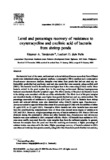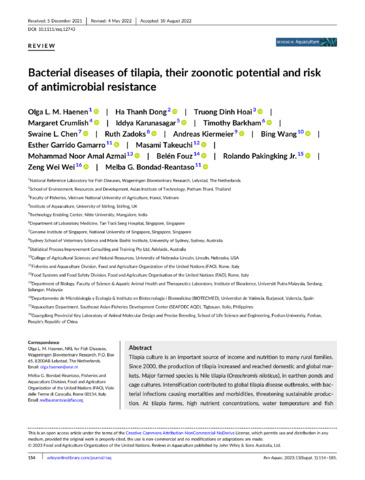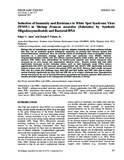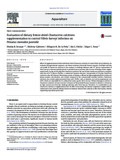Level and percentage recovery of resistance to oxytetracycline and oxolinic acid of bacteria from shrimp ponds
Share
စိတ္တဇ
The bacterial level of the water, sediment and cultured shrimp (Penaeus monodon) from different ponds were determined using a general medium, a presumptive Vibrio medium and a presumptive Pseudomonas–Aeromonas medium. Samples were taken from ponds that had not used any antimicrobial, ponds that had previously used and also ponds that were currently using oxolinic acid (OXA). The bacterial level in the sediment was higher than in the water using all three media. More bacteria existed in the pond system than in the receiving environment. Shrimp hepatopancreas harbored more bacteria than the lymphoid organ. The Vibrio density of the pond and bacterial levels in the shrimp were correlated with the use of the antimicrobial. The Vibrio level of the pond samples and microbial density of shrimps were higher from ponds that had not used any antimicrobials.
The percentage recoveries of resistance to oxytetracycline (OTC) and OXA in bacteria from shrimp ponds and cultured shrimps were also determined using Zobell's marine agar, Pseudomonas–Aeromonas selective agar and thiosulfate citrate bile sucrose agar (TCBS) with the addition of either 25 μg/ml OTC or 25 μg/ml OXA. Presumptive Vibrio bacteria and other bacterial taxa recovered from the pond/receiving water/sediment from all three sites showed some degree of resistance to OTC and OXA. However, a higher percentage recovery of strains resistant to OTC than to OXA was observed among the presumptive vibrios and other bacterial taxa. Pseudomonas and Aeromonas bacteria were more resistant to OXA compared with the vibrios. All bacterial taxa resistant to OTC were more readily recovered from the water samples than from the sediment samples. In general, between the samples from the pond and from the receiving environment, a higher percentage of resistant strains was observed in the latter. Higher percentage recovery of bacteria resistant to OXA was observed in shrimp from ponds currently using OXA than those from ponds that had not used any or those that had previously used them. The results of the present study showed that the percentage recovery of resistance reflected the pattern of antimicrobial use.
Suggested Citation
Tendencia, E., & de la Peña, L. D. (2002). Level and percentage recovery of resistance to oxytetracycline and oxolinic acid of bacteria from shrimp ponds. Aquaculture , 213(1-4), 1-13. https://doi.org/10.1016/S0044-8486(02)00017-0
ဘာသာရပ်
Taxonomic term
စုစည်းမှုများ စုစည်းမှုများ
- AQD Journal Articles [1249]
Related items
Showing items related by title, author, creator and subject.
-
Bacterial diseases of tilapia, their zoonotic potential and risk of antimicrobial resistance
Haenen, Olga; Thanh Dong, Ha; Hoai, Truong Dinh; Crumlish, Mags; Karunasagar, Iddya; Barkham, Timothy; Chen, Swaine; Zadoks, Ruth; Kiermeier, Andreas; Wang, Bing; Garrido Gamarro, Esther; Takeuchi, Masami; Amal, Mohammad Noor Azmai; Fouz, Belén; Pakingking, Rolando V., Jr.; Zeng, Weiwei; Bondad-Reantaso, Melba (Wiley, 2023-03-05)Tilapia culture is an important source of income and nutrition to many rural families. Since 2000, the production of tilapia increased and reached domestic and global markets. Major farmed species is Nile tilapia (Oreochromis ... -
Induction of immunity and resistance to white spot syndrome virus (WSSV) in shrimp Penaeus monodon (Fabricius) by synthetic oligodeoxynucleotide and bacterial DNA
Amar, Edgar C.; Faisan, Joseph P., Jr. (University of the Philippines Los Baños, 2012)Shrimps like all invertebrates are believed to lack true adaptive immunity but recent evidence indicate that they can be protected against pathogenic organisms by priming their immune system with immunostimulatory substances. ... -
Evaluation of dietary freeze-dried Chaetoceros calcitrans supplementation to control Vibrio harveyi infection on Penaeus monodon juvenile
Seraspe, Ebonia B.; Gabotero, Shirleny; de la Peña, Milagros R.; Pahila, Ida G.; Amar, Edgar (Elsevier, 2014)Effects of supplementation of diets with freeze-dried Chaetoceros calcitrans to control Vibrio harveyi infection are evaluated through immune responses, and disease resistance of juvenile Penaeus monodon. Total lipid and ...




